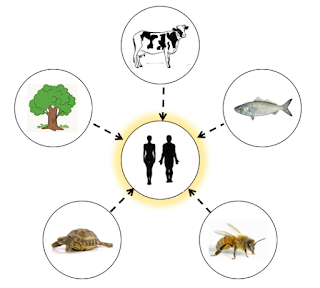On Ecolinguistics (Part II)
by Rodrigo Cáceres
Ecolinguistics is one of the main areas of semiotics, which is the study of signs. I claim that ecolinguistics is the study of how languages as conceptual sign systems relate to and influence other kinds of signs systems that are present in human existence (i.e. sensations, emotions, images, sounds, concepts, rules).
The best example we can find to understand this is to take a look at the logic of Western Culture: We have a culture that for millennia has been constantly fascinated, passionate and obsessed about the sign-concept of "truth" or "knowledge" and it has thus become a culture that has historically committed to try to reach it.
Since what we do is always based on emotions, the "quest for truth" is founded on the basic emotions of curiosity, admiration, attachment, amazement, desire and conviction. In this sense, the sign-concepts of "truth", "reality" and "knowledge" seem to be arguably the most attractive kinds of signs that could exist out there.
Since what we do is always based on emotions, the "quest for truth" is founded on the basic emotions of curiosity, admiration, attachment, amazement, desire and conviction. In this sense, the sign-concepts of "truth", "reality" and "knowledge" seem to be arguably the most attractive kinds of signs that could exist out there.
This is why the main cultural products of Western Culture are philosophy (philosophy literally means love of knowledge, pursuit of wisdom in Greek) and science, and this is why the main topics of philosophy are truth, reality and epistemology, the latter concerning theories on how to gain objective knowledge. In this kind of cultural commitment, at the individual level it is seen and lived as an individual commitment: a practice that requires discipline, order, intelligent use of time and elimination of distractions.
It is precisely in this schema where somatophobia arises, which we discussed in the last post as being a historical pattern in Western Culture of despising the body, done by central authors such as Plato, Augustine and Rene Descartes. Simply put, these people thought and wrote that having a body is pretty much the worst thing that could have happened to us, and that we are forever condemned to be carrying this burden around. Somatophobia as a practice is also founded on emotions, which in this case are guilt, hatred, shame, contempt, embarrassment, rejection, scorn, hostility, discomfort, distrust, fear and disgust.
Why such hatred towards the body? Precisely because what happens in the body is seen as a distraction on the quest for Truth: sexual pleasure, sensory pleasures, orgasms, lust, emotions, appetites and passions. These are seen as a "waste of time", a "diversion or distraction", as "deviant" in the path towards Truth and so on.
(This is also why in our culture time is lived, thought and talked about as a precious and limited resource: in this schema of the quest for truth time is something precious and cannot be wasted. This is what we know as the conventional metaphor of TIME IS A RESOURCE (Lakoff & Johnson, 1980))
Why such hatred towards the body? Precisely because what happens in the body is seen as a distraction on the quest for Truth: sexual pleasure, sensory pleasures, orgasms, lust, emotions, appetites and passions. These are seen as a "waste of time", a "diversion or distraction", as "deviant" in the path towards Truth and so on.
(This is also why in our culture time is lived, thought and talked about as a precious and limited resource: in this schema of the quest for truth time is something precious and cannot be wasted. This is what we know as the conventional metaphor of TIME IS A RESOURCE (Lakoff & Johnson, 1980))
It is in this somatophobic context in which Christianity arises and that is the reason why Christianity is extremely repressive towards the body, sexuality and sexual pleasure. I cannot help to remember some phrases I've seen in pop culture that reflect this vividly. The first one being in the context of a protest about global warming, where I saw a girl's banner that reads "You manage the planet just as bad as our clitoris".
If you identify with this situation or if reading this made you feel at least slightly uncomfortable, you are the living proof of a reactive pattern that is the consequence of sign systems shaping each other, in this case language and somatophobic theories shaping our relationship with the dimension of sexuality, sexual pleasure, genitals, masturbation and orgasms, as something to be hidden, rejected, avoided, shameful, dirty, sinful, and so on.
In formal terms, people convinced of somatophobic theories (which are made out of concept-signs) reshape and model their relationship towards their own body, creating patterns of sign-production (emotion-signs, sensations-signs) such as fear, disgust, hatred, shame, denial and discomfort towards dimensions of experience such as sexuality. It is literally the negation and repression of certain (sexual) signs by other kinds of (conceptual) signs. Adding a major religion such as Christianity actively promoting somatophobia, we see it becoming a cultural pattern that is widespread in the subjective experiences of people throughout the world.
Processes of sign negation such as this one are common in Western Culture, we have also the example of speciesism, which is the negation to recognize and consider the wellbeing of animals, plants and the land we live in. This negation process happens because our culture lives seeing the environment as a storehouse of resources that need to be exploited, so the living beings that exist in our environments and their welfare are permanently absent from our minds; these hegemonic discourses of instrumental relationships towards the world implicitly assume that plants and animals do not have rights to live nor to dwell in healthy environments.
Sign negation is suicidal force, it is self-destructive, as we are seeing in the current ecological catastrophe that unfortunately will only get worse in the coming years, bringing more death and destruction.
Ecolinguistics is thus about the ecological interactions of signs, about their dynamic interactions and relationships, how they influence and shape each other, creating in this case the kinds of sexually repressed and ecocidal worlds in which we live in.
Processes of sign negation such as this one are common in Western Culture, we have also the example of speciesism, which is the negation to recognize and consider the wellbeing of animals, plants and the land we live in. This negation process happens because our culture lives seeing the environment as a storehouse of resources that need to be exploited, so the living beings that exist in our environments and their welfare are permanently absent from our minds; these hegemonic discourses of instrumental relationships towards the world implicitly assume that plants and animals do not have rights to live nor to dwell in healthy environments.
Sign negation is suicidal force, it is self-destructive, as we are seeing in the current ecological catastrophe that unfortunately will only get worse in the coming years, bringing more death and destruction.
Ecolinguistics is thus about the ecological interactions of signs, about their dynamic interactions and relationships, how they influence and shape each other, creating in this case the kinds of sexually repressed and ecocidal worlds in which we live in.





Comments
Post a Comment